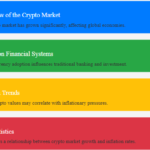What is inflation?
In this article, we discuss how the crypto market influences inflation rates. The cryptocurrency market is displaying its impacts on the global economies in a concrete way. One more fascinating area of influence is inflation rates. The inflation rate, mainly traditionally considered a function of old-fashioned economic elements, could be affected by the rise of digital money and alter inflation patterns and the global economy.

Before diving into the cryptocurrency market, it is essential to understand what inflation means. Inflation is the rate at which the general price level of goods and services increases, resulting in a decrease in purchasing power. In simpler terms, when inflation is high, the money you have available allows you to buy less than before.
Imagine you could buy a candy bar for $1 today. If inflation is 2% per year, that same candy bar will cost $1.02 next year. Over time, if inflation persists, you will need more money to buy the same things.
This article will How the Crypto Market Influences Inflation rates unpack the intricate ways the cryptocurrency market interacts with inflation, perhaps unearthing leads and consequences. Let us proceed to discuss how the crypto market influences inflation rates and what it might imply for the future.
Understanding Inflation and Its Traditional Drivers
Before understanding the role of crypto, let us talk of inflation. Inflation is the rate at which the general price level of goods and services is increasing and consequently eroding purchasing power. Traditionally, there are two causes of inflation: Demand-Pull Factors- When demand exceeds supply, prices rise. Cost-Push Factors- If prices are rising because of costs, such as wages or raw materials.
Monetary Policy: The central banks which include the Federal Reserve, set interest rates and manage the money supply so that inflation remains stable.
All these factors in the management of inflation rates are very important between economies. However, with the emergence of cryptocurrencies, they dig into complicated ways of how the crypto Market influences inflation rates.
How the Crypto Market Influences Inflation Rates
Control of supply and fixed supply assets
In contrast, most cryptocurrencies like Bitcoin come with a fixed supply cap. For example, Bitcoin has a cap set at 21 million coins. No more can ever be produced, so the cap limit cannot ever be broken. This scarcity ensures cryptocurrencies are not susceptible to inflationary pressures from excessive money printing-also a characteristic associated with the devaluation of fiat currency.
On the contrary, in economies showing high inflation, it can be observed that investors opt for cryptocurrencies as a store of value, thus increasing demand for crypto assets. This causes a diversion of reliance from the traditional fiat currency and indirectly reduces the velocity of money in circulation, resulting in an impact on inflation.
Crypto as an Inflation Hedge
Bitcoins and other cryptocurrencies are sometimes known as “digital gold” because they can act as a hedge against inflation. Where rising inflation means that more investors are looking for items to store value well into the future, like gold but increasingly, crypto currencies, the moment the wealth is moved from traditional currencies to crypto, it would reduce some of the monetary pressures of inflation on fiat currencies due to less money available in circulation.
However, it has to be commented that crypto is not flawless due to its highly volatile nature, which serves as a hedge, while in case of a drastic fall in the price, this might pose serious losses to investors in return, thus countering its potential being a reliable hedge against inflation.

Decentralized Finance (DeFi) and Impact on Interest Rates
Decentralized finance, or DeFi, platforms have mushroomed to offer alternative channels for lending, borrowing, and earning interest without the intermediation required in traditional banking. According to many, this new development can influence the interest rates of traditional loans, thereby affecting inflation.
A rise in demand for DeFi for finance-related uses increases the demand for stablecoins (crypto-currencies pegged to a more stable asset like the U.S. dollar), which reduces the usage of loans based on traditional currencies. As central banks monitor money velocity, such a shift towards DeFi can make inflation-management a bit of a complex issue by making monetary policy less effective.
Crypto Market Volatility and Consumer Price Index (CPI)
Beyond affecting investor portfolios, Crypto’s volatility affects far more than just the balance sheets of investors. Those businesses that accept cryptocurrency payments are in the position of having to deal with dramatic value swings, which may influence the price of goods and services to prevent or mitigate losses. This could hit the CPI, especially in regions where widespread crypto use has occurred.
For example, if a company alters the prices of products according to the changes seen in the crypto market, it can bring in new price changes, thereby affecting the measures of inflation and CPI.
CBDCs and Controlling Inflation
After the crypto boom, many central banks are examining or developing CBDCs. Such fiat digital currencies give central banks greater control over money supply and therefore inflation rates. Though different from cryptocurrencies, such implementation reflects the influence of the crypto market on global finance.
Using CBDCs, the central banks would effectively control money supplies, hence influencing inflation. The knowledge of the people’s adoption of cryptocurrencies offers the central banks the chance to handle CBDCs in a better way such that the nation gets a stable level of inflation as well as economic robustness.
Potential Risks and Future Implications of Crypto on Inflation
Increased Volatility of the Inflation Rate
The very nature of crypto as decentralized and speculative introduces volatilities in financial markets. As adoption of crypto increases, then so may price fluctuations in crypto amplify their impacts on inflation. This would make inflation rates further impossible to stabilize for central banks, especially if increasingly many individuals and corporates begin holding and transacting with crypto.
Issues for Central Banks
Any cryptocurrencies are independently run, which poses a challenge in using traditional monetary policy to control inflation since central banks do not have an easy way out to influence these types of supply. This lack of control of crypto supply also complicates monetary policy and thus makes their inflation management less effective.

Probability of Hyperinflation for Fragile Economies
In economies prone to a weak local currency or at risk of hyperinflation, crypto has served as a haven to store stable value. While this shift may well safeguard personal wealth, it could further accelerate the national currency’s decline and tighten the drag of inflation. Countries experiencing fast inflation, like Venezuela, have seen an increase in crypto adoption as citizens attempt to preserve the purchasing power of their currencies.
However, adoption would flip the global trade and inflation levels around. When more firms begin to do transactions using stablecoins and other cryptocurrencies, this might reduce reliance on the U.S. dollar. This would consequently minimize the inflation pressures that directly result from fluctuations in the U.S. dollar, thereby possibly changing global economic ties.
How the Crypto Market Influences Inflation Rates in 2024
1. Alternative investment
Cryptocurrencies are often considered an alternative investment to traditional assets like stocks and bonds. When people invest in cryptocurrencies, they can withdraw their money from traditional financial systems.
How the Crypto Market Influences Inflation Rates: If a significant number of investors choose to hold cryptocurrencies rather than cash, this may reduce demand for traditional currencies. This decrease in demand can lead to a weaker currency, thereby contributing to higher inflation rates.
2. Dynamics of supply and demand
The value of cryptocurrencies is heavily influenced by supply and demand. When demand for a particular cryptocurrency increases, its price increases. Conversely, if demand decreases, the price falls.
Example: If more people start buying Bitcoin, its price increases. As a result, investors could sell their traditional assets to buy Bitcoin, which could cause fluctuations in the traditional market and affect inflation.
3. Central bank policies
Central banks, like the Federal Reserve in the United States, control the money supply in the economy. When central banks increase the money supply, it can lead to inflation.
How the Crypto Market Influences Inflation Rates: As cryptocurrencies gain popularity, central banks may feel compelled to adjust their policies. They could raise interest rates to curb inflation or even consider creating their own digital currencies, known as central bank digital currencies (CBDCs). These changes can have a direct impact on inflation rates.
4. Market Volatility
The cryptocurrency market is known for its volatility, with prices often experiencing significant fluctuations over short periods of time. This volatility can influence investor behavior and economic stability.
Impact on inflation: If a sudden drop in cryptocurrency prices occurs, investors could panic and sell their traditional assets, leading to instability in financial markets. This instability can create uncertainty, which could lead to inflationary pressures as consumers react to changing economic conditions.
5. Global economic factors
How the Crypto Market Influences Inflation Rates: Cryptocurrencies operate on a global scale, meaning they are not limited to the economy of a single country. Global events, such as economic crises or geopolitical tensions, can impact both the cryptocurrency market and inflation rates.
Example: If a country is facing economic difficulties, investors may turn to cryptocurrencies as a safe haven, causing prices to rise. This change may influence inflation rates in that country, as demand for its traditional currency declines.

The relationship between the crypto market and inflation rates is complex but important to understand. Cryptocurrencies serve as alternative investments, influencing supply and demand dynamics, central bank policies, and market volatility. As the popularity of digital currencies continues to grow, their impact on inflation rates will likely become more significant.
Young investors and economics enthusiasts can gain valuable insights into the broader financial landscape by closely monitoring the crypto market. Understanding how these digital currencies interact with traditional economic factors like inflation can help you make informed decisions in the future.
Conclusion
How the Crypto Market Influences Inflation Rates the influence of the crypto market on inflation is complex and multifaceted, providing potential benefits but also possible challenges. Once digital currencies are further intertwined in global finance, they will continue to affect inflation in ways yet unknown. Although cryptocurrencies like Bitcoin are an investment hedge against inflation, volatility and speculation create challenges for investors and policymakers.
As the world of DeFi unfolds and that of CBDCs dawns, adaptation occurs and brings upon new economic realities that challenge central banks and financial institutions. It is in the light of such adaptation that the interaction of cryptocurrency inflation is sure to play a pivotal role in ensuring continued economic stability within the digital economy.
How the Crypto Market Influences Inflation Rates

In contrast, most cryptocurrencies like Bitcoin come with a fixed supply cap. For example, Bitcoin has a cap set at 21 million coins. No more can ever be produced, so the cap limit cannot ever be broken.
How the Crypto Market Influences Inflation Rates
